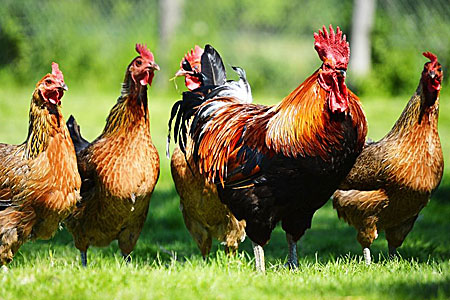
Everyone uses the word “flock” when referring to chickens. But what is a flock? And how many chickens make a flock?
Definition of Flock
According to Merriam-Webster, a flock is a group of animals (such as birds or sheep) assembled or herded together. The dictionary that came on my computer further refines the definition as a number of birds of one kind, or a number of domestic animals, especially sheep, goats, or geese, that are kept together.
The word flock, according to the Online Etymology Dictionary, derives from the Old English flocc “a group of persons, company, troop.” In Old English, the word referred to humans only. Around the year 1200 the word was extended to include a number of animals of one kind moving or feeding together. The reference to a flock consisting of birds first appeared in the 1800s.
USDA’s Flock
The USDA considers a backyard flock to consist of fewer than 1,000 birds (domestic poultry). In contrast, a commercial flock (actually called a commercial poultry operation) has 1,000 or more birds.
For a backyard flock, size depends on the total number of birds present, regardless of species. A small backyard flock consists of fewer than 20 total birds. A medium flock has 20 to 99 total birds. A large flock runs all the way from 100 to 999.
Breeding Flock
A breeding flock usually consists of at least one rooster and a number of hens of the same breed and variety. Exactly how many hens per rooster are in a breeding flock depends on a lot of factors, including the size and agility of the birds, and the purpose of the breeding program.
Exhibition breeders, as well as those working to restore endangered genetics, often work with pairs (one rooster, one hen), trios (one rooster, 2 hens) or quartets (one rooster, 3 hens). Backyard hobby breeders tend to size their flocks according to recommended mating ratios.
Chicken Society
A flock of chickens organizes itself according to an established pecking order. And the arrangement of the pecking order depends on how many other chickens each chicken remembers.
When a chicken meets another chicken it doesn’t recognize, the two want to establish (or re-establish) their respective positions in the pecking order. Peck order conflicts are disruptive and stressful.
The Poultry Extension Website states that a laying hen is able to recognize around 30 other chickens. Beyond that, up to 60 chickens, each bird loses track of its place in the pecking order, causing the peaceful social structure to break down.
Interestingly, though, when a flock includes more than 60 chickens, the birds become less aggressive and more tolerant of each other. But presumably not as peaceful as a flock consisting of 30 or fewer chickens.
Realistic Flock Size
Not many backyard flocks have more than 30 chickens (or even multiple poultry species combined). Larger flocks are more appropriate for large or extended families, someone who sells eggs, or a serious breeder.
More typical for a backyard layer flock is 6 to 12. A flock of pet chickens generally includes 3 to 6 birds. Fewer than three is not enough for the chickens to meet their social needs.
So how many chickens make a flock? If the word flock describes multiple birds, and factors in their establishment of a social structure, then a flock consists of at least 3 chickens.
And that’s today’s news from the Cackle Coop.
Gail Damerow has written numerous books about poultry, including The Chicken Encyclopedia.

